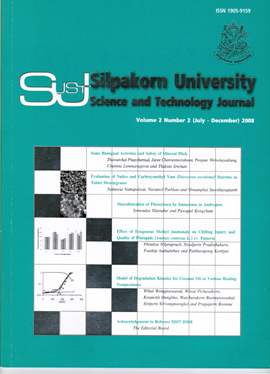Some Biological Activities and Safety of Mineral Pitch
Main Article Content
Abstract
Mineral pitch, a form of mineral dripping from the cracks of the rocks, has been historically used throughtopical and oral administrations for health benefits. Its biological activities and safety have not been wellcharacterized. The purpose of this study was to investigate the antioxidative activity, antimicrobial activity,cytotoxicity and heavy metal determination of mineral pitch in comparison to coal tar. The total phenolic contentand antioxidative activity of mineral pitch were higher than those of coal tar. Antimicrobial activities againstStaphylococcus aureus, Escherichia coli and Candida albicans of mineral pitch were less than coal tar. Adichloromethane extract of mineral pitch could inhibit the growth of those three microbes, while the butanolextract showed the growth inhibition on S. aureus and C. albicans. From the MTT assay, mineral pitch wasnotably toxic to normal human lung fibroblast (MRC-5), human breast carcinoma cells (MDA-MB-231), humanlung carcinoma cells (A549), human cervical carcinoma cells (Hela), human colorectal adenocarcinoma cells(SW-620), human ovarian carcinoma cells (SKOV-3) and human hepatocarcinama cells (HepG2). Inductivelycoupled plasma-mass spectrometry (ICP-MS) analysis indicated the high content of heavy metals, especially,As, Hg, and Pb in mineral pitch which might relate to the cytotoxicity.
Downloads
Article Details
References
Agarwal, S. P., Khanna, R., Karmarkar, R., Anwer, M. K., and Khar, R. K. (2007). Shilajit: a review. Phytotherapy Research, 21(5): 401-5.
Andre, C. M., Ghislain, M., Bertin, P., Oufir, M., Herrera, M., Hoffmann, L., Hausman, J. F., Larondelle, Y., and Evers, D. (2007). Andean potato cultivars (Solanum tuberosum L.) as a source of antioxidant and mineral micronutrients. Journal of Agricultural FoodChemistry, 55(2): 366-78.
Ashida, R., Nakgawa, K., Oga, M., Nakagawa, H., and Miura, K. (2008). Fractionation of coal by use of high temperature solvent extraction technique and characterization of the fractions. Fuel, 87(4-5): 576-582.
Azpíroz, G., Blanco, C. G., and Banciella, C. (2008). The use of solvents for purifying industrial naphthalene from coal tar distilled oils. Fuel Processing Technology, 89(2): 111-117.
Bhattacharya, S. K. and Sen, A. P. (1995). Effects of Shilajit on biogenic free radicals. Phytotherapy Research, 9: 56-59.
DiSepio, D., Chandraratna, R. A. S., and Nagpal, S. (1999). Novel approaches for the treatment of psoriasis. Drug Discovery Today, 4(5): 222-231.
Frotan, M. H. and Acharya, S. B. (1984). Pharmacological studies of shilajit. Indian Journal Pharmacocology, 16: 45.
Ghosal, S., Baumik, B., and Chattopadhyay, S. (2006a). Shilajit induced morphometric and functional changes in mouse peritoneal macrophages. Phytotherapy Research, 9(3): 194-198.
Ghosal, S., Lal, J., Singh, S. K., Goel, R. K., and Bhattacharya, S. K. (1991). The need for formulation of Shilajit by its isolated active constituents. Phytotherapy Research, 5: 211-216.
Ghosal S., Reddy J. P., and Lal V. P. (1976). Shilajit I: chemical constituents. Journal of Pharmaceutical Sciences, 65(5): 772-773.
Ghosal, S., Singh, S. K., Kumar, Y., Srivastava, R., Goel, R. K., Dey, R., and Bhattacharya, S. K. (2006 b). Anti-ulcerogenic activity of fulvic acids and 4-methoxy-6-carbomethoxybiphenyl isolated from shilajit. Phytotherapy Research, 2 (4): 187-191.
Goel, R. S. and Acharya, S. B. (1990). Antiulcerogenic and antiinflammatory studies with Shilajit, Journal of Ethnopharmacology, 29: 95–103.
Hartman, M. (2007). Shilajit Plus. [Online URL: http://www.tattvasherbs.com/shilajit/htm] accessed on Jan 1, 2008.
IARC. (1985). Internatioanal Agency for Research on Cancer. IARC Monographs on the evaluation of the carcinogenic risk of chemicals to humans. Polynuclear aromatic compounds, part 3. industrial exposures in aluminium production, coal gasification, coke production, and iron and steel founding, vol. 34, pp. 219.Lyon, France.
Jaiswal, A. K. and Bhattacharya, S. K. (1992). Effects of Shilajit on memory, anxiety and brain monoamines in rats, Indian Journal of Pharmacology, 24: 12–17.
Kipling, M. D. and Waldron, H. A. (1976). Polycyclic aromatic hydrocarbons in mineral oil, tar, and pitch, excluding petroleum pitch. Preventive Medicine, 5(2): 262-278.
Kocan, R. M., Matta, M. B., and Salazar, S. M. (1996). Toxicity of weathered coal tar for short nose sturgeon (Acipenser brevirostrum) embryos and larvae. Archives Environmental Contamination & Toxicology, 31(2): 161-165.
Kumazawa, S., Taniguchi, M., Suzuki, Y., Shimura,M., Kwon, M. S., and Nakayama, T. (2002). Antioxidant activity of polyphenols in Carob Pods. Journal of Agricultural and Food Chemistry, 50(2): 373-377.
Mosmann, T. (1983). Rapid colorimetric assay for cellular growth and survival: Application to proliferation and cytotoxicity assays. Journal of Immunological Methods, 16: 55-63.
Park, J. S, Kim, G. Y., and Han, K. (2006). The spermatogenic and ovogenic effects of chronically administered Shilajit to rats. Journal of Ethnopharmacology, 107(3): 349-53
Phillips, P. (1997). Unearthing the evidence. [OnlineURL: http://www.msinp.com/herbs/product/processed_shilajit/ezine_issue_No_3_Mar_1997_Unearthing_the_evidence.htm] accessedon April 27, 2008.
Re, R., Pellegrini, N., Proteggente, A., Pannala, A., Yang, M., and Rice-Evans, C. (1999). Anitoxidant activity applying an improved ABTS radical cation decolorization assay. Free Radical Biology and Medicine, 26: 1231-1237.
Richaud, R., Lachas, H., Collot, A., Mannerings, A. G., Herod, A. A., Dugwell, D. R., andKandiyoti, R. (1998). Trace mercury concentrations in coals and coal-derived material determined by atomic absorption spectrophotometry. Fuel, 77(5): 359-368.
Saper, R. B., Kales, S. N., Paquin, J., Burns, M. J., Eisenberg, D. M., Davis, R. B., and Phillips, R. S. (2004). Heavy metal content of Ayurvedic herbal medicine products. Journal of the American Medical Association, 292(23): 2868-2873.
Thai Herbal Pharmacopoeia Vol. 2 (2000). pp. 121- 123. Prachachon Co., Ltd., Bangkok.
Thami, G. P. and Sarkar, R. (2002). Coal tar: past, present and future. Clinical and Experimental Dermatology, 27(2): 99-103.
White, P. A. and Claxton, L. D. (2004). Mutagens in contaminated soil: a review. Mutation Research/Reviews in Mutation Research, 567(2-3): 227-345.

